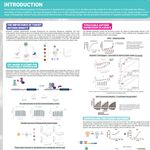Measurement of DNA Methylation and Nuclear Organization with Nanopore Sequencing
Nanopore sequencing has enormous potential in epigenetic applications; unlike traditional sequencing-by-synthesis technologies, it can distinguish covalently modified nucleotides directly through their modulation of the electrolytic current. We can take advantage of the long read lengths generated by nanopore sequencing to precisely call methylation patterns, and to obtain phased methylation information across the genome. The promise of nanopore sequencing has already been demonstrated by the accurate calling of 5-methylcytosine in a CG context using hidden Markov models (nanopolish) and neural networks (Megalodon). We have now trained our models on other modified (non-canonical) nucleotides, focussing here on dam-mediated adenosine methylation (N6-mA). Methylated adenosine sequencing has applications in bacterial epigenetics as well as exogenous labeling in mammalian systems. In particular, the DamID method uses a dam enzyme fused to a protein of interest, e.g. nuclear lamina, resulting in labeling DNA proximal to the protein. We are able to detect this N6-mA modification simultaneously with 5mC, providing two distinct epigenetic signatures along long single DNA molecules. We applied this to mammalian cells treated by DamID to characterize lamin-associated domains (LADs). LADs showed on average significantly higher methylation profiles than other regions in our pipeline. Applying this model we can simultaneously measure phased nuclear positioning information (LADs) with DNA cytosine methylation (5-mC) using long reads. With this method, we have explored CTCF binding sites and CpG islands on the border of LADs to investigate their mechanism.
Learning Objectives:
1. Base modification detection using nanopore sequencing
2. Simultaneous profiling of DNA methylation and lamina-associated domains




